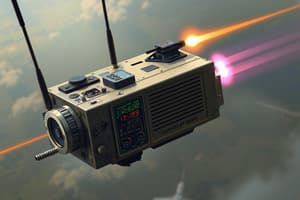Podcast
Questions and Answers
What is the primary role of feature detectors in image processing?
What is the primary role of feature detectors in image processing?
- To extract image color information
- To compress image size for storage
- To apply filters for noise reduction
- To identify interest points in images (correct)
Which of the following is NOT a feature detector mentioned?
Which of the following is NOT a feature detector mentioned?
- Lowe Detector (SIFT)
- Interest Point Detector
- Canny Edge Detector (correct)
- Harris Detector
What is the next step after identifying interest points in image processing?
What is the next step after identifying interest points in image processing?
- Feature description (correct)
- Image blending
- Noise reduction
- Feature matching
What is the primary purpose of feature matching in the context of image processing?
What is the primary purpose of feature matching in the context of image processing?
Which of the following describes the term 'feature descriptor'?
Which of the following describes the term 'feature descriptor'?
What is a common application area for feature detection and matching?
What is a common application area for feature detection and matching?
Which feature detector is associated with Scale-Invariant Feature Transform?
Which feature detector is associated with Scale-Invariant Feature Transform?
What factor is crucial for determining whether a feature is a good candidate?
What factor is crucial for determining whether a feature is a good candidate?
What does the term 'Recall' refer to in the context of evaluating feature matchers?
What does the term 'Recall' refer to in the context of evaluating feature matchers?
Which value represents perfect specificity in a feature matcher evaluation?
Which value represents perfect specificity in a feature matcher evaluation?
What does the AUC (Area Under the Curve) indicate in the context of ROC analysis?
What does the AUC (Area Under the Curve) indicate in the context of ROC analysis?
What does a false positive rate of 0 imply in the evaluation of a feature matcher?
What does a false positive rate of 0 imply in the evaluation of a feature matcher?
In a Receiver Operating Characteristic (ROC) curve, what does the x-axis typically represent?
In a Receiver Operating Characteristic (ROC) curve, what does the x-axis typically represent?
What technique does SIFT use to improve the location accuracy of extrema?
What technique does SIFT use to improve the location accuracy of extrema?
What happens to a keypoint if the intensity change at its location is below a certain threshold?
What happens to a keypoint if the intensity change at its location is below a certain threshold?
How many bins are used in the orientation histogram for each keypoint in SIFT?
How many bins are used in the orientation histogram for each keypoint in SIFT?
In the keypoint descriptor stage, how is the 16x16 window divided?
In the keypoint descriptor stage, how is the 16x16 window divided?
How many dimensions does the keypoint descriptor consist of?
How many dimensions does the keypoint descriptor consist of?
What type of changes can SIFT handle effectively?
What type of changes can SIFT handle effectively?
What is the maximum viewpoint change SIFT can handle?
What is the maximum viewpoint change SIFT can handle?
What is a characteristic feature of SIFT in terms of performance?
What is a characteristic feature of SIFT in terms of performance?
What is the primary purpose of scale-space extrema detection in computer vision?
What is the primary purpose of scale-space extrema detection in computer vision?
Which step involves accurately locating the feature keypoints?
Which step involves accurately locating the feature keypoints?
What is assigned to keypoints during the orientation assignment stage?
What is assigned to keypoints during the orientation assignment stage?
What characteristic makes a function 'good' for scale detection?
What characteristic makes a function 'good' for scale detection?
Which of the following is NOT a stage of the SIFT feature detection process?
Which of the following is NOT a stage of the SIFT feature detection process?
What does taking a local maximum of the function in scale-space extrema detection help to achieve?
What does taking a local maximum of the function in scale-space extrema detection help to achieve?
In computer vision, what does scale invariance refer to?
In computer vision, what does scale invariance refer to?
What is represented as a high-dimensional vector in the SIFT feature detection process?
What is represented as a high-dimensional vector in the SIFT feature detection process?
What is the purpose of thresholding in the Harris corner detection process?
What is the purpose of thresholding in the Harris corner detection process?
Which corner detector is mentioned as having a slight modification to improve results over the Harris Corner Detector?
Which corner detector is mentioned as having a slight modification to improve results over the Harris Corner Detector?
What property does the Harris corner response exhibit in relation to image rotation?
What property does the Harris corner response exhibit in relation to image rotation?
Which of the following is NOT a property that SIFT is reasonably invariant to?
Which of the following is NOT a property that SIFT is reasonably invariant to?
What role do derivatives play in achieving invariance to intensity shifts in corner detection?
What role do derivatives play in achieving invariance to intensity shifts in corner detection?
In what way is the Harris corner detector affected by scaling?
In what way is the Harris corner detector affected by scaling?
Which feature detection method was developed by David Lowe in 1999?
Which feature detection method was developed by David Lowe in 1999?
How does the Harris corner response function in relation to eigenvalues?
How does the Harris corner response function in relation to eigenvalues?
What computational step follows the computation of the corner response (R) in corner detection?
What computational step follows the computation of the corner response (R) in corner detection?
Which aspect does SIFT not specifically address for feature detection?
Which aspect does SIFT not specifically address for feature detection?
Flashcards are hidden until you start studying
Study Notes
Harris Corner Detection
- Calculate x and y derivatives of the image
- Calculate products of derivatives at every pixel
- Calculate the sum of the products of derivatives at each pixel
- Define the matrix at H each pixel
- Calculate the response of the detector at each pixel (R)
- Threshold the value of R and perform non-max suppression
- Compute a feature descriptor for each pixel that meets the criteria in the previous step
Harris Corner Response
- Corner response is rotation invariant
- Ellipse rotates but its shape (eigenvalues) remains the same
- Corner response R is invariant to image rotation
Harris Corner Response: Intensity Changes
- Partially invariant to affine intensity change
- Only derivatives are used => invariant to intensity shift
- Intensity scaling: I → a I
Harris Corner Detection: Scaling
- Not invariant to changes in scaling
- All points will be classified as edges if scaling is applied to a corner
Shi-Tomasi Corner Detector
- A small modification to the Harris Corner Detector
- Shows better results compared to Harris Corner Detector
- If a value is greater than a threshold, it’s considered a corner
Scale Invariant Feature Transform (SIFT)
- Developed by David Lowe (ICCV 1999)
- Local feature detector and descriptors
- Reasonably invariant to changes in illumination, image noise, rotation, scaling and small changes in viewpoint
SIFT Features
- Over 60,000 citations of the journal and conference versions
- Patented by the University of British Columbia (Canada)
Detection Stages for SIFT Features
- Scale-space extrema detection
- Key point localization
- Orientation assignment
- Keypoint descriptor
Scale-space Extrema Detection
- Scale Invariant Detection
- Design a function on the region which has the same shape even if the image is resized
- Take a local maximum of this function
Scale-space Extrema Detection: Choosing Windows
- How do we choose corresponding windows independently in each image?
- Do objects have a characteristic scale that we can identify?
Scale-space Extrema Detection: Choosing Windows: Solution
- Design a function on the region which has the same shape even if the image is resized
- Take a local maximum of this function
Scale-space Extrema Detection: Choosing Windows: A Good Function
- A “good” function for scale detection has one stable sharp peak
SIFT: Robust
- Extraordinarily robust matching technique
- Can handle changes in viewpoint (up to about 60 degrees)
- Can handle significant changes in illumination (sometimes even day vs.night)
- Fast and efficient (can run in real time)
Key Point Localization
- SIFT also used Taylor series expansion of scale space to get more accurate location of extrema
- If the intensity change (i.e., the contrast) is below a certain threshold, the keypoint is rejected because it indicates that the region around that keypoint is too flat.
Orientation Assignment for SIFT
- A neighborhood is taken around the key point location depending on the scale, and the gradient magnitude and direction is calculated in that region.
- An orientation histogram with 36 bins covering 360 degrees is created.
Keypoint Descriptor for SIFT
- A descriptor is computed for the local image region about each key point
- 16x16 window around the keypoint is taken.
- It is divided into 16 sub-blocks of 4x4 size
- Based on 16*16 patches
- 4*4 sub regions
- 8 bins in each sub region
- 448=128 dimensions in total
Evaluating Results: ROC Curve
- How can we measure the performance of a feature matcher?
- ROC curve (“Receiver Operator Characteristic”)
- Single number: Area Under the Curve(AUC)
-
true positives / # matching features (positives) = true positive rate = recall
-
false positives / # unmatched features (negatives) = false positive rate = 1 - specificity
What Makes a Good Feature/Interest Points?
- What defines whether a feature is a good or bad candidate?
- Consider a small window of pixels
Key Point Stages of Selection
- Initial interest points
- Keypoint localization (after gradient threshold)
- Keypoints after ratio threshold
Feature Extraction
- How do we combine two images?
Feature Extraction: Steps
- Identify interest points(features) in both images
- Extract vector feature descriptor surrounding each interest point
- Determine correspondence between descriptors in two views
Feature Extraction: Panorama Stitching
- Combine two images to stitch a panorama
Studying That Suits You
Use AI to generate personalized quizzes and flashcards to suit your learning preferences.




